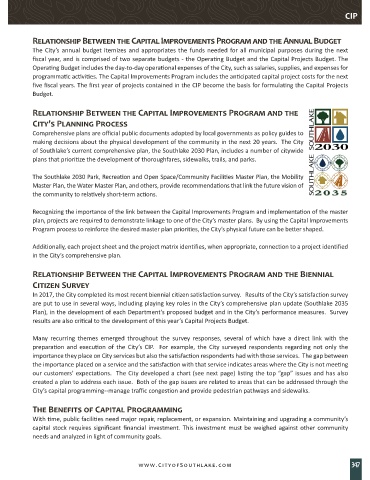Page 348 - Southlake FY20 Budget
P. 348
CIP
Relationship Between the Capital Improvements Program and the Annual Budget
The City’s annual budget itemizes and appropriates the funds needed for all municipal purposes during the next
fiscal year, and is comprised of two separate budgets - the Operating Budget and the Capital Projects Budget. The
Operating Budget includes the day-to-day operational expenses of the City, such as salaries, supplies, and expenses for
programmatic activities. The Capital Improvements Program includes the anticipated capital project costs for the next
five fiscal years. The first year of projects contained in the CIP become the basis for formulating the Capital Projects
Budget.
Relationship Between the Capital Improvements Program and the
City’s Planning Process
Comprehensive plans are official public documents adopted by local governments as policy guides to
making decisions about the physical development of the community in the next 20 years. The City
of Southlake’s current comprehensive plan, the Southlake 2030 Plan, includes a number of citywide
plans that prioritize the development of thoroughfares, sidewalks, trails, and parks.
The Southlake 2030 Park, Recreation and Open Space/Community Facilities Master Plan, the Mobility
Master Plan, the Water Master Plan, and others, provide recommendations that link the future vision of
the community to relatively short-term actions.
Recognizing the importance of the link between the Capital Improvements Program and implementation of the master
plan, projects are required to demonstrate linkage to one of the City’s master plans. By using the Capital Improvements
Program process to reinforce the desired master plan priorities, the City’s physical future can be better shaped.
Additionally, each project sheet and the project matrix identifies, when appropriate, connection to a project identified
in the City’s comprehensive plan.
Relationship Between the Capital Improvements Program and the Biennial
Citizen Survey
In 2017, the City completed its most recent biennial citizen satisfaction survey. Results of the City’s satisfaction survey
are put to use in several ways, including playing key roles in the City’s comprehensive plan update (Southlake 2035
Plan), in the development of each Department’s proposed budget and in the City’s performance measures. Survey
results are also critical to the development of this year’s Capital Projects Budget.
Many recurring themes emerged throughout the survey responses, several of which have a direct link with the
preparation and execution of the City’s CIP. For example, the City surveyed respondents regarding not only the
importance they place on City services but also the satisfaction respondents had with those services. The gap between
the importance placed on a service and the satisfaction with that service indicates areas where the City is not meeting
our customers’ expectations. The City developed a chart (see next page) listing the top “gap” issues and has also
created a plan to address each issue. Both of the gap issues are related to areas that can be addressed through the
City’s capital programming--manage traffic congestion and provide pedestrian pathways and sidewalks.
The Benefits of Capital Programming
With time, public facilities need major repair, replacement, or expansion. Maintaining and upgrading a community’s
capital stock requires significant financial investment. This investment must be weighed against other community
needs and analyzed in light of community goals.
www.CityofSouthlake.com 347

